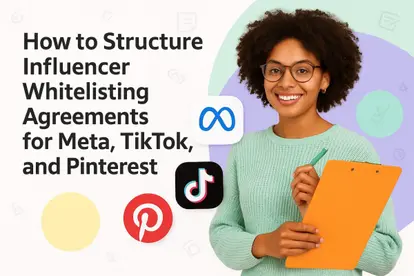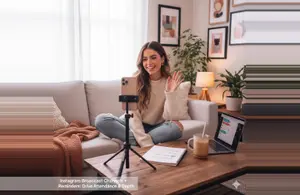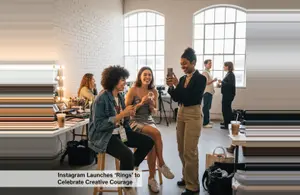Why are creators quoting a 20-25% surcharge every time a brand asks to boost their Reel? And why are those same creators swapping tips on TikTok about how to spot an ad that keeps running long after the contract ends? Those two questions sum up the new reality of whitelisting.
Across beauty tutorials, fitness vlogs, and finance explainers, the data reveals a consistent pattern: brands want the credibility of a creator handle, creators want protection from flights, and both sides dread the comment-moderation storm that paid reach can unleash.
Yet the mechanics—Spark codes, Brand Collabs invitations, audit clauses—remain hazy even for seasoned marketers.
This guide turns that haze into an executable workflow. You’ll learn how to price permissions, slot them into your brief timeline, request access in minutes, and keep every flight compliant. By the end, advertiser access will feel less like trivia and more like a lever you control.
- Why Whitelisting Sits at the Center of 2025 Paid-Social Growth
- Strategic Stakes of Whitelisting
- Pricing & Legal Foundations for Advertiser-Access Deals
- Step-by-Step Guide for Requesting Advertiser Access From Creators
- Negotiation Playbook: Securing Advertiser Access on Favorable Terms
- Launch, Optimise, Report: Turning Permissions Into Performance
- From Handle to Habitual High-ROI
- Frequently Asked Questions
Why Whitelisting Sits at the Center of 2025 Paid-Social Growth
Whitelisting has moved from nice-to-have to line-item essential in almost every performance-oriented influencer brief. The commercial stakes, however, extend well beyond improved media efficiency.
Once a creator’s likeness appears in a paid unit, that individual inherits perpetual comment-moderation risk, competitor visibility, and potential audience confusion over long-running endorsements. Smart marketers recognise this asymmetry and proactively price the privilege.
@lissettecalv Replying to @the.ali.way let’s get deep about whitelisting in brand campaigns, how much to charge for whitelisting, and why it matter for Creators and influencers ✏️ #influencermarketing #influencer101 #influencertips #creatortips ♬ Astro Beat - Staysee
Before legal talks begin, slot whitelisting into the Influencer Brief → Go-Live timeline:
- Brief template (Day 0)
- Talent short-list (Day 3-6)
- Content draft (Day 15)
- Advertiser-access request sent with post ID attached (Day 17)
- Go-live (Day 25)
- Flight-audit checkpoint (Day 55)
This timeline lets performance, legal, and creator-relations teams build fees, flight dates, and support tickets into the same work-back schedule, eliminating the last-minute scramble many brands still face.
Agency and in-house paid social leads, therefore, need a governance framework that addresses three realities:
- Media-Buy Leverage Shift — The brand captures incremental sales lift, whereas the creator’s follower count rarely budges. Negotiations must be anchored to brand value, not the promise of “exposure.”
- Time-Bound Licensing Economics — Prevailing benchmarks have converged on a 20-25% licensing fee per 30-day flight, but multi-platform boosts, evergreen usage, or exclusivity radii can drive that multiplier substantially higher.
- Verification & Audit — Contract language should guarantee the creator the right to pull data from Meta Ad Library, TikTok Creative Center, or a third-party dashboard to confirm ad flights cease on schedule, reducing contentious back-billing later.
Taken together, these forces mean that requesting advertiser access is no longer a casual DM; it is a structured commercial negotiation requiring technical accuracy (Business Manager IDs, Spark codes), legal clarity (rights, flight dates, community-management duty-of-care), and financial discipline (renewal options, late-flight penalties).
Strategic Stakes of Whitelisting
Senior growth teams increasingly treat whitelisting as the first paid-social test, not an add-on. Quarterly debriefs from leading agencies reveal that many DTC brands now brief creator-handle ads in Wave 1 because the format sidesteps “banner blindness” and ships faster than asset-heavy brand spots.
This shift forces marketers to master advertiser-access logistics before the creative even leaves Figma.
What Whitelisting Actually Is
At its core, whitelisting is an advertising permission: the creator authorises a brand to run paid ads from the creator’s social identity. On Meta, that means Branded Content Ads; on TikTok, it’s Spark Ads; YouTube uses channel permissions.
Unlike dark posts run from a brand handle, a whitelisted ad inherits the creator’s avatar, byline, and legacy engagement, making the placement appear peer-generated rather than corporate.
Why It Delivers Outsized Performance And Brand Risk
Ads served from creator handles routinely deliver higher view-through rates because the creative is perceived as native.
Pinterest quietly joined the party in March 2025 by opening Collab Ads to creator handles; early testers in beauty verticals report noticeably lower CPMs than brand-run Promoted Pins.
Pinterest requires a one-click claim inside its Creator Rewards Hub — a step many brands miss, causing delayed go-live dates. Brands, therefore, leverage whitelisting to push high-performing organic posts to look-alike audiences at scale.
Yet that same reach exposes creators to a new layer of scrutiny: trolls, adversarial competitors, and consumers who conflate paid endorsement with long-term ambassador status. Best-practice briefs now include a brand-funded community-management retainer or explicit indemnity on reputational fallout.
Distinguishing Whitelisting from Paid Usage and “Dark Boosts”
Paid usage allows the brand to run the asset from its own handle; whitelisting runs from the creator’s. Contracting teams must separate the two in scopes of work, assign unique flight windows, and attach independent fee ladders. Treating them interchangeably erodes negotiating power and blurs accountability for ad-library auditing.
Benchmark Pricing Patterns
The most defensible starting point remains 20-25% of the sponsored-content base fee for every 30-day window, escalating for:
- Cross-platform propagation (Reel + TikTok + Shorts)
- Evergreen flights beyond 90 days
- High-exclusivity verticals (nutrition, finance, pharmaceuticals)
- Talent with significant offline likeness value (e.g., household TV personalities)
Marketers should memorialise those multipliers in a fee grid attached to the master services agreement, preventing renegotiation on every campaign.
Governance Must-Haves
- Flight-Date Kill Switches: Meta’s Brand Collabs Manager and CreatorIQ “Handshake” both allow automatic expiry — use them.
- Ad-Library Watchlists: Weekly checks safeguard against overrun flights and enable timely renewal discussions.
- Comment Moderation SOPs: Define response tiers (FAQ replies, hide, escalate) before the first dollar is spent.
Strategic Payoff: Fold these governance checkpoints into your standard Influencer Ops Playbook; when creator-handle ads sit inside the same Monday board as product seeding, the media team gains instant clarity on renewal dates, legal sees rights expiry at a glance, and creators experience fewer urgent Slack pings, raising satisfaction scores that directly reduce talent-turnover costs.
Pricing & Legal Foundations for Advertiser-Access Deals
Whitelisting fees are best framed as a media-licensing surcharge layered on top of your standard sponsored-content rate card. The logic is simple: the brand is effectively renting the creator’s likeness, engagement history, and placement in the auction.
Below is a repeatable framework senior marketers can drop into every influencer SOW.
Rate-Setting Grid
| Flight Length | Baseline Multiplier* | Common Uplifts |
|---|---|---|
| 0–30 days | 20 %-25% of base post fee | None (starter tier) |
| 31–90 days | Baseline × 1.5 | Evergreen positioning (e.g., always-on retargeting) |
| 91–180 days | Baseline × 2 – 2.5 | Multi-platform boost (Reel + TikTok + Short) |
| 181–365 days | Custom quote | Category exclusivity or high-reg-risk sectors |
*Benchmarks surfaced repeatedly in our creator-brand campaign analysis.
Five Variables That Move the Multiplier
- Platform Mix: Spark + Branded-Content + Collab Ads in one SOW raises moderation overhead and increases brand benefit.
- Creative Volume: Carousel + Reel variants or sequential TikTok hooks justify premium tiers.
- Likeness Prominence: Face-forward beauty tutorials command more than over-the-shoulder product demos.
- Geo-Scope: Country clusters beyond a single market elevate both paid-media reach and potential competitor conflicts.
- Exclusivity Radius: Clinically regulated verticals (OTC skincare, supplements) often insist on 90-day non-compete windows.
Contract Clauses You Cannot Skip
- Precise Flight Dates: Frame them as business-manager permissions, not vague “three-month” language.
- Ad-Library Audit Rights: Insert a clause allowing creators to pull weekly snapshots from Meta Ad Library or TikTok Creative Center; breach triggers a 100% surcharge.
- Community-Management Duty-of-Care: Brand funds hide/delete protocols and escalation paths for harassment or misinformation.
- Indemnity & Caps: Mirror paid-media budgets rather than flat caps; most creators now peg liability to 1× licensing revenue.
- Kill Switch Language: Require business-manager access to be revoked within 24 hours of flight expiry.
Step-by-Step Guide for Requesting Advertiser Access From Creators
Advertiser-access requests are where influencer briefs most commonly stall—legal red lines collide with ad-tech friction, leaving paid-media dollars idle. A tight, platform-specific workflow lets performance, legal, and creator-relations teams move from “approved concept” to live spend inside a single sprint, preserving launch windows and safeguarding creator goodwill.
| Platform | Creator Instructions | Brand-Side Steps |
|---|---|---|
| Meta (Instagram/Facebook) | Settings ► Ads & Payments ► “Connect Partner” ► Enter Business-Manager ID ► Approve assets. | Business Manager ► Brand Collabs Manager ► “Request Ad Creation” ► Select handle ► Auto-notify creator. |
| TikTok Spark Ads | Open post ► “Ad Settings” ► “Generate Code” ► Share eight-digit code. | TikTok Ads Manager ► Spark Assets ► “Apply Code” ► Build campaign with creator identity. |
| YouTube Partner / Google Ads | Channel ► Settings ► Permissions ► Invite brand e-mail (Viewer-Limited). | Google Ads ► Linked Accounts ► Accept invite ► Build Video campaign with creator channel as ad source. |
| Pinterest Collab Ads | Claim invitation in Creator Rewards Hub ► Approve promoted pin. | Ads Manager ► Draft campaign ► Attach creator pin once claim is confirmed. |
- Strategic Payoff: Mapping these steps to a JIRA template with “Definition of Done” check-boxes gives media buyers a predictable path to time-to-first-impression KPI ownership, while legal gains an immutable log of flight-date compliance, minimising revenue leakage from out-of-scope spend.
Negotiation Playbook: Securing Advertiser Access on Favorable Terms
Whitelisting negotiations succeed when marketers remember that a creator’s likeness is an asset with measurable media value, not an optional add-on. The playbook below helps brand and agency teams advance from first outreach to a countersigned SOW without eroding creator goodwill or overpaying for rights that never get used.
Frame the Ask in Business Terms
Lead with the why: “We’d like to amplify the post that already generated 9% click-through on your feed via Branded-Content Ads to reach in-market shoppers.”
By tying the request to specific performance goals and budget, you anchor the conversation in ROI rather than vague “exposure.”
Translate Budget to a Fee-Setting Ladder
- Base Creation Fee: Compensates for production and organic post.
- Whitelisting Surcharge: 20-25% of the base per 30-day flight
- Uplift Triggers:
- Multi-platform boost (+0.5×)
- Evergreen rights beyond 90 days (+0.5–1×)
- Category exclusivity (+0.25×)
- 24-hour turnaround (+flat rush fee)
Negotiation tip: Use a sliding table rather than a single number; creators can see how each variable affects payout and are less likely to perceive the brand as low-balling.
Handle Common Push-Back
| Creator Concern | Brand Response |
|---|---|
| “Boosting might kill my organic reach.” | Offer a reach cap (e.g., 2M impressions) and a mid-flight performance check. |
| “Your ad might scare off competing sponsors.” | Present a short exclusivity radius with a paid buy-out for extensions. |
| “I’m worried about trolls.” | Provide a screenshot of your community-management SOP and fund moderation hours. |
Insert Audit & Renewal Language Early
Add a single paragraph: “Brand will cease spend on or before MM-DD-YYYY. Creator may verify via Meta Ad Library or TikTok Creative Center. Over-run impressions will be billed at 2× the agreed surcharge.”
This clause protects both parties and accelerates legal sign-off.
Upsell Options Creators Actually Take
- Variant Testing Package — Three hook variations filmed in one session, licensed at 50 % of base surcharge.
- Geo-Split Rights — APAC usage priced separately so EU exclusivity remains intact.
- Comment Co-Moderation — Shared Sprout queue unlocks a lower surcharge in exchange for brand labor.
@tanicha_rose Here’s why you should be whitelisting your content👀 #influencer101 #influencertips #microinfluencertips #microinfluencertiktok #contentcreator #blackcontentcreator #branddeals ♬ original sound - Tanicha Rose
Launch, Optimise, Report: Turning Permissions Into Performance
Securing advertiser access is only half the game; the real lift comes from disciplined execution once the toggle flips from Pending to Active.
Use this five-pillar framework to convert creator-handle ads into predictable revenue without burning creative, budget, or talent relationships.
1. Campaign Build & Naming Conventions
Ad-set names should surface the creator, asset ID, and flight dates (CR_SkinCoach_IGReel_20250801-0830). This reduces QA back-and-forth and speeds up auditing when contracts renew.
2. Budget & Bid Strategy
- Meta: Start with Advantage+ Placements, but cap the learning budget at 20% of total spend to avoid over-indexing on cheap but low-intent inventory.
- TikTok: Use “Bid Cap” for upper-funnel reach, then switch to “Cost Cap” once the asset logs >50 conversions.
- Pinterest Collab Ads: Set frequency at ≤3 impressions per user per 7 days to preserve creator credibility.
3. Community-Management Workflows
Route whitelisted-ad comments into the brand’s Zendesk instance but tag them with a CR_ prefix so creator-specific sentiment can be exported separately. A three-tier protocol (FAQ reply → hide → escalate) keeps SLAs tight and spares the creator’s inbox.
4. KPI Framework
| Stage | Primary KPI | Secondary Signal |
|---|---|---|
| Hook | 3-second view rate | Thumb-stop rate (Meta) |
| Mid-View | 15-second hold (TikTok) | Percentage watched (YouTube) |
| Action | LP view cost | Add-to-cart rate |
| Relationship | Sentiment delta vs. creator norm | Follower lift (optional) |
Set the renewal go/no-go at 80% of flight length. If LP view cost is within 110% of brand-handle benchmarks and sentiment delta remains ≤ -5%, trigger an auto-renew proposal.
5. Weekly Reporting Cadence
Monday exports from Meta Ads Manager and TikTok Ads Manager drop into Google Sheets via Supermetrics; Looker Studio auto-builds a slide for Thursday stand-ups. A single share-link keeps creator, agency, and brand in sync, slashing email threads.
From Handle to Habitual High-ROI
Whitelisting isn’t a one-off media trick; it’s a repeatable growth discipline that touches every node of influencer operations—briefing, legal, creative, paid social, and community care. When permissions, pricing, and post-flight auditing live in one airtight workflow, brands unlock a compounding advantage: creator trust stays high, legal risk stays low, and paid-media lift shows up on the P&L faster than fresh creative can be storyboarded.
As you roll the playbook into your next campaign, treat advertiser access as a shared asset—licensed, safeguarded, and measured with the same rigor you apply to first-party data. Do that, and the creator’s handle becomes more than a logo substitute; it becomes a performance lever you can pull—confidently—quarter after quarter.
Frequently Asked Questions
How can I adapt a whitelisting brief for different markets without rewriting everything?
Start with a master template, then swap in region-specific cultural cues, compliance lines, and ad-copy variants—a method outlined in this guide to localizing a single brief for multiple regions.
What’s an efficient structure for running whitelisted ads all year, not just for campaigns?
Build a tiered calendar of evergreen assets, refresh checkpoints, and renewal triggers using the always-on program framework so you’re never scrambling for new permissions.
Should I prioritise macro or micro creators when I need quick advertiser access?
For fast approvals and lower CPMs, micro creators often win—yet macros provide scaled reach if you have a strong permissions workflow; compare both routes in the macro-vs-micro briefing breakdown.
How do I keep creative freedom intact while still protecting brand guidelines in whitelisted ads?
Lock only the mandatory legal and brand-safety elements, then give creators runway on storytelling—mirroring the balance described in the freedom-vs-guidelines playbook.
What should a multi-platform whitelisting brief include beyond post IDs?
Add platform-specific ratios, staging deadlines, and flight-date tables; a concise template lives in the multi-platform launch checklist.
How can I benchmark whitelisting fees for a DTC product rollout?
Peg the surcharge to 20-25% of the base post fee per 30 days—an approach woven into the DTC launch brief creation guide.
Can generative AI draft whitelisting clauses without legal bloat?
Yes—prompt libraries in AI-powered brief drafting show how to auto-insert platform permissions and audit language in seconds.
How does a mood-board speed up creative approval for whitelisted assets?
Visual references align tone before filming, reducing revision rounds; see storyboard hacks in creator mood-board techniques.
What disclosure lines are non-negotiable in a whitelisting agreement?
You’ll need paid-partnership tags plus FTC-aligned copy; a checklist of mandatory phrasing is summarised in the legal requirements for usage-rights briefs.




